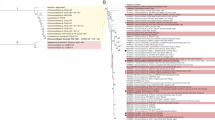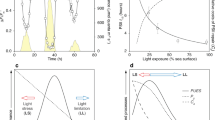Abstract
The cyanobacterium known as Acaryochloris marina is a unique phototroph that uses chlorophyll d as its principal light-harvesting pigment instead of chlorophyll a, the form commonly found in plants, algae and other cyanobacteria; this means that it depends on far-red light for photosynthesis. Here we demonstrate photosynthetic activity in Acaryochloris-like phototrophs that live underneath minute coral-reef invertebrates (didemnid ascidians) in a shaded niche enriched in near-infrared light. This discovery clarifies how these cyanobacteria are able to thrive as free-living organisms in their natural habitat.
Similar content being viewed by others
Main
Acaryochloris marina was first isolated from extracts of didemnid ascidians1,2 and was presumed to be a symbiont, like the cyanobacterium Prochloron sp., which contains chlorophyll a and b, and is found inside didemnids3. Acaryochloris marina has been found on red algae4 and a free-living Acaryochloris-like organism has been discovered in a turbid saline lake5. This indicates that cyanobacteria containing chlorophyll d may be fairly widespread, yet little is known about their habitat and ecology.
In a microphotometric survey of the didemnid ascidians Lissoclinum patella, Trididemnum paracyclops, Diplosoma similis and Diplosoma virens, we investigated the occurrence and distribution of cells containing chlorophyll d (for methods, see supplementary information). Prochloron, and some unicellular cyanobacteria containing chlorophyll a and phycobiliproteins, colonized internal cavities of the didemnids, but we found no evidence of chlorophyll d in the ascidians. However, biofilms growing on the underside of the didemnids contained clusters of pale, greenish-yellow Acaryochloris-like morphotypes: these had spectral absorption and fluorescence features that were characteristic of chlorophyll d (Fig. 1a, b; and see supplementary information).
a, Vertical section through D. virens, showing the green cells of symbiotic cyanobacterium Prochloron sp. inside cavities, and a biofilm (white) patch of Acaryochloris-like cells growing on the underside of the ascidian (scale bar, 2 mm). b, Top, spectral absorbance (solid lines) and ultraviolet-excited fluorescence (dashed lines) of cells from the biofilm shown in a (red curves) and cells from an A. marina culture (blue curves). Arrow, absorption maximum of chlorophyll d. Data were normalized to the maximal absorbance and fluorescence, respectively. Bottom, spectral irradiance measured below D. virens after the biofilm had been removed, expressed as a percentage of downwelling irradiance at the tissue surface. c, d, Images as in a, but showing the maximal photosystem-II (PSII) quantum yield of the dark-adapted section (c) and the effective PSII quantum yield at an irradiance of 585 µmol photons m−2 s−1 (d). Both variables were scaled to the same colour gradient (0–1). e, PSII quantum yield (dashed lines) and relative rates of photosynthesis (solid lines) as a function of irradiance in Prochloron symbionts (green) and in Acaryochloris-like cells (red), taken from areas circled in a.
We cultured these Acaryochloris-like cells from the biofilm. Sequence analysis of the isolate (results not shown) indicates that the genes that encode cells' light-harvesting protein (pcbC) and 16S ribosomal RNA correspond to those of A. marina: there is 100% identity with the 302-base-pair polymerase-chain-reaction fragment and 99% identity with the 392-base-pair fragment, respectively (NCBI database6).
Fibre-optic microprobe measurements7 in D. virens showed intense attenuation of visible light. Far-red light penetrated more efficiently through the ascidian tissue, and was enhanced relative to the incident light owing to light-trapping effects3,7. Under all ascidians, visible light was strongly depleted but there was 10–20 times more far-red light, providing an ideal niche for cyanobacteria containing chlorophyll d, which absorbs maximally at 700–720 nm (Fig. 1b).
We used variable chlorophyll fluorescence imaging to assess photosynthesis of the cyanobacteria containing chlorophyll d in their natural habitat. Maximal quantum yields of photosystem II (PSII) were 0.77 and 0.59 in zones comprising Prochloron and Acaryochloris-like cells, respectively (Fig. 1c). Maximal PSII quantum yields of 0.67–0.80 have been reported for A. marina cultures8.
As expected, the quantum yield of PSII decreased with increasing irradiance (Fig. 1d). Surprisingly, the Acaryochloris-like cells were, like Prochloron, able to sustain high photosynthetic activity at strong light intensity (Fig. 1e). A similar light adaptation is also evident in A. marina9.
It is an apparent paradox that Acaryochloris-like cells thrive in extreme shade but show features of adaptation to strong light. This unusual photoacclimation reflects the fact that they live in an environment rich in near-infrared light and that chlorophyll d is the main light-harvesting pigment that drives both photosystems I and II under these conditions7,10.
We conclude that Acaryochloris-like cyanobacteria grow in biofilms beneath didemnid ascidians, where far-red is enhanced over visible light and is used for oxygenic photosynthesis. This explains the occurrence of epiphytic A. marina on the underside of red algae4. Cyanobacteria that contain chlorophyll d may thrive in other habitats with little visible light, but further microenvironmental controls may be important in defining the niche of these microorganisms.
References
Miyashita, H. et al. Nature 383, 402 (1996).
Miyashita, H., Ikemoto, H., Kurano, N., Miyachi, S. & Chihara, M. J. Phycol. 39, 1247–1253 (2003).
Kühl, M. & Larkum, A. W. D. in Symbiosis: Mechanisms and Model Systems (ed. Seckbach, J.) 273–290 (Kluwer, Dordrecht, 2002).
Murakami, A., Miyashita, H., Iseki, M., Adachi, K. & Mimuro, M. Science 303, 1633 (2004).
Miller, S. R. et al. Proc. Natl Acad. Sci. USA 102, 850–855 (2005).
Chen, M., Hiller, R. G., Howe, C. J. & Larkum, A. W. D. Mol. Biol. Evol. 22, 21–28 (2005).
Kühl, M. & Fenchel, T. Microb. Ecol. 40, 94–103 (2000).
Schiller, H., Senger, H., Miyashita, H., Miyachi, S. & Dau, H. Fed. Eur. Biochem. Soc. Lett. 410, 433–436 (1997).
Miyashita, H. et al. Plant Cell Physiol. 38, 274–281 (1997).
Boichenko, V. A., Klimov, V. V., Miyashita, H. & Miyachi, S. Photosynth. Res. 65, 269–277 (2000).
Author information
Authors and Affiliations
Corresponding author
Ethics declarations
Competing interests
The authors declare no competing financial interests.
Supplementary information
Supplementary Methods
Description of the methods applied in the study, including key references. (DOC 36 kb)
Supplementary Figure
An additional example of microscopic analysis showing the presence of Chl d-containing cyanobacteria in epizoic biofilms below the didemnid ascidian Lissoclinum patella. A 6-panel figure comprising photographs and absorbance spectra of Chl d-containing cyanobacteria. A figure legend is included below the figure. (PDF 1067 kb)
Rights and permissions
About this article
Cite this article
Kühl, M., Chen, M., Ralph, P. et al. A niche for cyanobacteria containing chlorophyll d. Nature 433, 820 (2005). https://doi.org/10.1038/433820a
Published:
Issue Date:
DOI: https://doi.org/10.1038/433820a
This article is cited by
-
Isolation and characterization of trimeric and monomeric PSI cores from Acaryochloris marina MBIC11017
Photosynthesis Research (2023)
-
Chlorophyll triplet states in thylakoid membranes of Acaryochloris marina. Evidence for a triplet state sitting on the photosystem I primary donor populated by intersystem crossing
Photosynthesis Research (2023)
-
Down to the bone: the role of overlooked endolithic microbiomes in reef coral health
The ISME Journal (2020)
-
Far-red light allophycocyanin subunits play a role in chlorophyll d accumulation in far-red light
Photosynthesis Research (2020)
-
Molecular dynamics simulations in photosynthesis
Photosynthesis Research (2020)
Comments
By submitting a comment you agree to abide by our Terms and Community Guidelines. If you find something abusive or that does not comply with our terms or guidelines please flag it as inappropriate.




